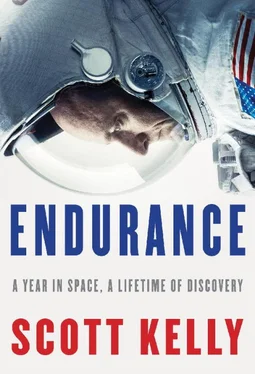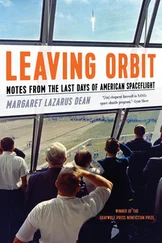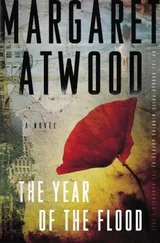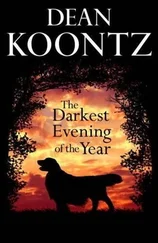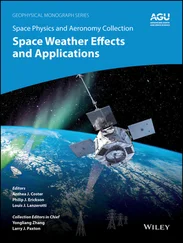As we scanned the area with the laser and looked at the images with the adjacent camera, my initial thought was, Oh, shit! The hole looked as though it went all the way through to the aluminum alloy that makes up the airframe. Later that evening, the ground emailed me photos of the damage. I printed out the most interesting pictures and carried them around in my pocket for the next couple of days.
There was a flurry of discussion on the ground about how this damage would affect our reentry. We didn’t have a lot of options in this situation. We could try to fix the damage on a spacewalk by filling the hole with a special putty that had never been proven in flight, or take our chances and land as is. I talked over the options with my crew, mostly with Scorch, whose technical knowledge I held in particularly high regard. I also talked with our two spacewalkers, Rick and Dave, since they would have to do any repairs if we decided to go that route. We came to the conclusion that we could fix the damage if we had to, but we would trust the analysis done on the ground if they told us we could reenter safely. The press immediately wrote that the crew was in imminent danger.
Teams of experts on the ground were conducting analysis on the damage and how the heat of reentry would affect the tiles. They made a mock-up of the damaged tiles and put it in a testing facility where gases can be heated to very high temperatures and subjected to hypersonic speeds using a continuous electrical arc to simulate the effects of reentry. As I learned about the analysis they were doing, I had more and more confidence that the damage would not present a risk and that we should leave it as it was. Some NASA experts disagreed and thought we should do the repair. My concern was that one small bump from a crew member’s tool or helmet could make the hole bigger, or create a new hole, and that the material and procedures for repairing tiles were still unproven. And, of course, any spacewalk presents inherent risks of its own.
—
THE DAY we were to return to Earth, we didn’t dwell on the risk. We readied the orbiter and its systems, got suited up and strapped ourselves into our seats, and began the reentry process. As we slammed into the atmosphere and built up heat, we watched the hot plasma streaming past our windows and imagined the battering of the shuttle’s heat shield. We all knew what could happen if our decision had been wrong.
“Passing through peak heating,” Scorch said calmly. This was the point when Columbia had started to break up.
“Understand,” I replied.
About twenty seconds later, we had passed the point where if the orbiter heat shield was burning through, we would have known about it.
“Looks like we dodged that bullet,” I said. I couldn’t help reflecting on our friends lost on Columbia, and I’m sure the rest of my crew was doing the same.
We were now inside the Earth’s atmosphere, and as we slowed below the speed of sound, I took over the controls from the autopilot. I was flying the space shuttle for the very first time in Earth’s atmosphere, and knew I would have only one chance to land.
As we dove seven times steeper than an airliner and descended twenty times faster, I felt the effects of gravity, vertigo, and a visual symptom called nystagmus, where your eyes jerk up and down. As we approached an altitude of two thousand feet, I tried to put these physical impairments out of my mind.
“Two thousand feet, preflare next,” Scorch said.
“Roger preflare, arm the gear” was my response, acknowledging his call and asking him to arm the landing gear system. As we passed through two thousand feet, I started slowly and deliberately raising the orbiter’s nose as I transitioned to a much shallower inner glide slope and started to rely more on the optical landing aids on the side of the runway and less on the orbiter’s instruments.
At three hundred feet I told Scorch, “Gear down.”
In response, Scorch pushed the button to lower the landing gear.
“Gear’s down,” he said.
From the time the landing gear were lowered until we landed was only about fifteen seconds. In that short period of time, I was trying to control the shuttle precisely in order to cross over the end of the runway at the correct height (twenty-six feet) and touch down at the correct speed (two hundred knots) with a rate of descent of less than two feet per second. We had a pretty heavy crosswind that day, which made all of this more challenging. I didn’t touch down exactly on centerline, but by the time we came to a stop, I was perfectly in the center of the runway. I think most space shuttle commanders who were also carrier aviators—Navy pilots and Marines who have landed on a ship at night—would agree that landing the orbiter was easier, all things being equal, though still one of the hardest piloting tasks. What made it hard was doing a perfect landing when you’ve been in space and are tired, dizzy, and dehydrated. And of course, when the world was watching.
—
A FEW MONTHS AFTER I returned from STS-118, I was in D.C. to visit with members of Congress and went out to dinner with Mark’s fiancée, Congresswoman Gabrielle Giffords. I’d first met Gabby in Arizona one afternoon a couple of years earlier when I went to pick up Mark at the airport. She was friendly, warm, and incredibly enthusiastic about her job as an Arizona state senator. I was impressed with her after our brief meeting, so much so that I joked to Mark that I wondered what she saw in him.
While we were eating, my phone rang, showing the number for Steve Lindsey, the chief of the Astronaut Office. As the fiancée of an astronaut, Gabby knew that when the chief astronaut calls at an unusual hour, you take the call.
“Scott, I’d like to assign you to a long-duration flight, Expedition Twenty-five and Twenty-six. You’d be the commander for Twenty-six.”
I hesitated before speaking. It’s always exciting to get a flight assignment, but spending five or six months on the International Space Station wasn’t exactly what I had been hoping for.
“Honestly, I’d rather fly as a shuttle commander again,” I said. “Is that possible?”
I knew the space shuttle inside and out, and I had only learned the basics about the Soyuz and the ISS. The Soyuz was a very different vehicle from the space shuttle, to say the least. I sometimes joked that Soyuz and the shuttle were similar in that they both carried people into space—and that was where the similarity ended. The Soyuz manuals and checklists were in Russian, for starters. And I would also need to learn more about the ISS, which had grown significantly in the last few years, inside and out.
I sighed. “When’s the launch date?” I asked.
“October 2010.”
“I understand. Let me talk to Leslie and my kids and I’ll get back to you.”
Five or six months away from home would be a long time, especially with Charlotte still so young. But I also knew I would take any flight assignment I was given. Leslie and the girls agreed this was an opportunity I couldn’t pass up, and I said I would take it.
Among the things I had to do before I could turn my attention to this new assignment was follow up about my high PSA count. It wasn’t alarmingly high, but it had jumped from its previous level, and the rate of change could be indicative of a problem. I visited a urologist, Dr. Brian Miles, at Houston’s Methodist Hospital, who gave me two options: we could wait six months and see whether my PSA continued to increase, which would give us more information about whether I did have prostate cancer, and if so, how aggressive it might be. Or he could do a biopsy right then. I asked what the risk of a biopsy was.
Читать дальше
